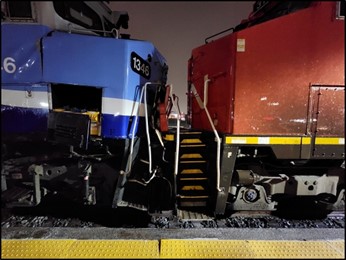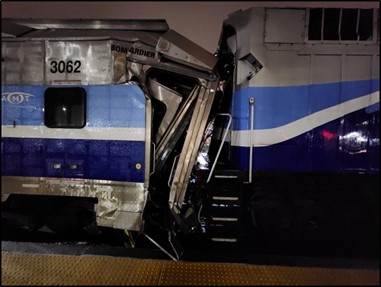Table of contents
Main-track collision and derailment
Canadian National Railway Company freight train X37631-20 and
Réseau de transport métropolitain (exo) commuter train EXO 1212
Mile 135.89, CN St-Laurent Subdivision
Montréal, Quebec
The occurrence
On 21 November 2023, exo commuter train 1212 (EXO 1212), consisting of a locomotive and 3 multilevel passenger cars with 8 passengers and 2 crew members on board, was stopped at the exo Saint-Léonard–Montréal-Nord station, at Mile 135.89 of the CN St-Laurent Subdivision.
After receiving a restricting signal at the previous intermediate signal, the crew of a CN freight train on the same track noticed the stopped commuter train in front of them. Even though the locomotive engineer immediately made an emergency application of the train brakes, the CN train collided with the rear portion of the commuter train and pushed it approximately 150 feet before coming to rest. Both CN locomotives sustained major damage, but it was the locomotive and one of the derailed exo train cars that sustained the most damage.
Four passengers as well as the 2 crew members on EXO 1212 were injured. The TSB is investigating.
Media materials
Investigation information
Download high-resolution photos from the TSB Flickr page.
Class of investigation
This is a class 3 investigation. These investigations analyze a small number of safety issues, and may result in recommendations. Class 3 investigations are generally completed within 450 days. For more information, see the Policy on Occurrence Classification.
TSB investigation process
There are 3 phases to a TSB investigation
- Field phase: a team of investigators examines the occurrence site and wreckage, interviews witnesses and collects pertinent information.
- Examination and analysis phase: the TSB reviews pertinent records, tests components of the wreckage in the lab, determines the sequence of events and identifies safety deficiencies. When safety deficiencies are suspected or confirmed, the TSB advises the appropriate authority without waiting until publication of the final report.
- Report phase: a confidential draft report is approved by the Board and sent to persons and corporations who are directly concerned by the report. They then have the opportunity to dispute or correct information they believe to be incorrect. The Board considers all representations before approving the final report, which is subsequently released to the public.
For more information, see our Investigation process page.
The TSB is an independent agency that investigates air, marine, pipeline, and rail transportation occurrences. Its sole aim is the advancement of transportation safety. It is not the function of the Board to assign fault or determine civil or criminal liability.


